MXA RACE TEST: 2018 TM MX450-FI
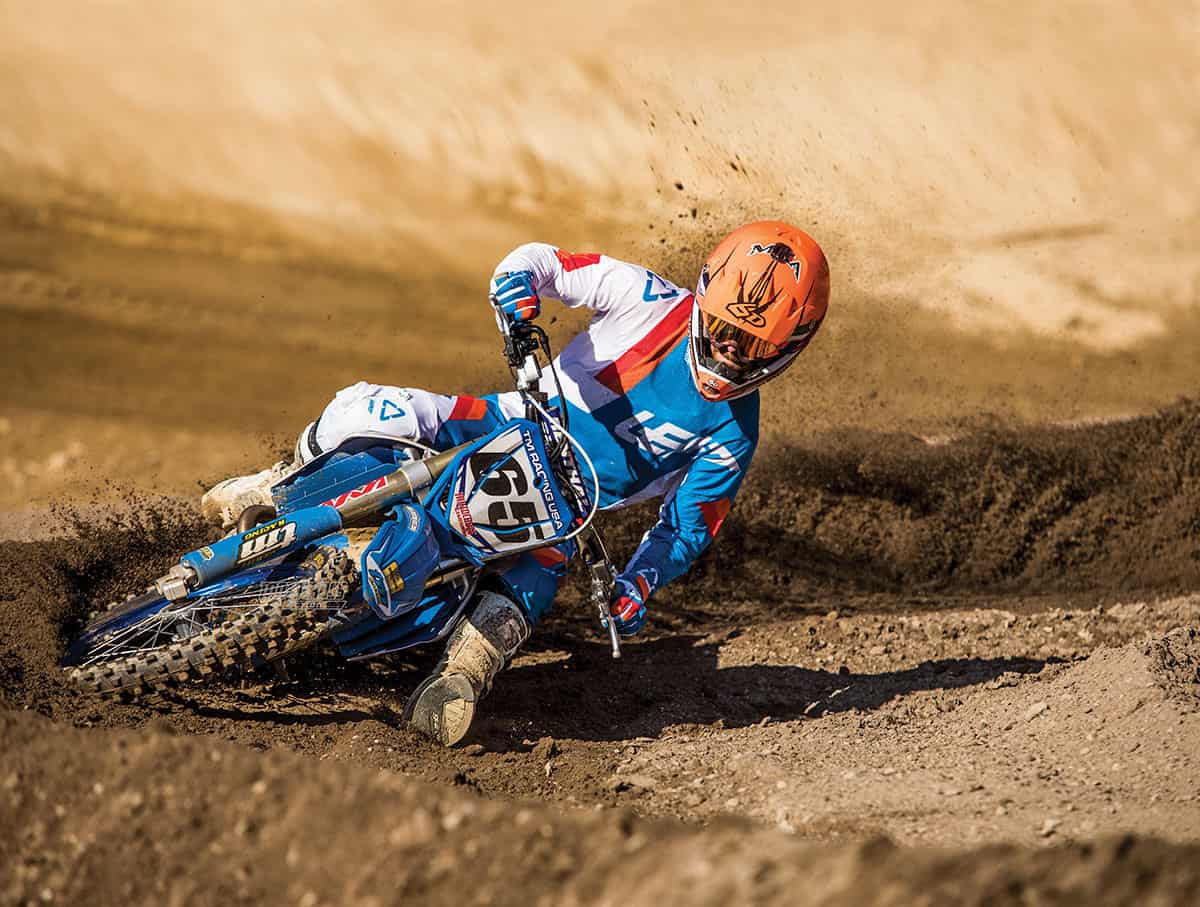
Boots: Gaerne SG12.
Q: IS THE 2018 TM MX450FI BETTER THAN THE 2017 MODEL?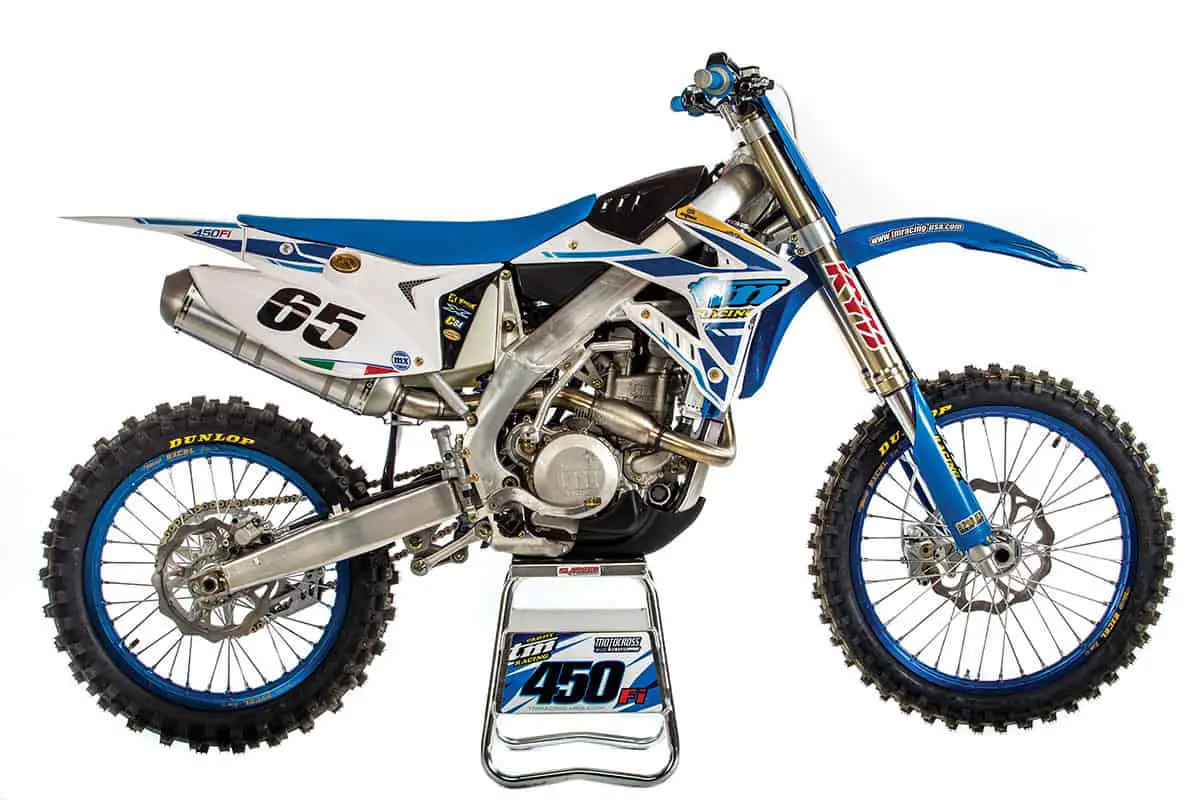 The 2018 TM MX450-FI looks identical to the TM MX450-FI we tested two years ago, but, boy, does it feel different on the track.
The 2018 TM MX450-FI looks identical to the TM MX450-FI we tested two years ago, but, boy, does it feel different on the track.
A: We didn’t test the 2017 model. We didn’t want to. It was basically the same exact bike we tested in 2016, which was a bike that suited the few, not the many. It was an oddly configured machine—too odd for American tastes. To be honest, we didn’t want to test the 2018 model, either. Why? Because TM Italy said they only made a few simple changes. We didn’t feel that a few changes made the bike worth testing again, but TM importer Ralf Schmidt told us that TM made a lot of changes. He didn’t know exactly what was different or why the Italians were being so tight-lipped, but he assured us that the 2018 TM MX450-FI was vastly different on the track. We took the bait, and lo and behold, he was right—but we still don’t know what they changed to make it happen.
Q: WHAT WAS UPDATED FOR 2018?
A: According to TM Italy, only the forks, frame and compression ratio have been updated, but we can’t believe that. The bike feels completely different. We think a lot of the improvements come from the Americanization of Ralf Schmidt. When Ralf moved to the USA from Holland to take over the TM importation business from longtime TM importer Pete Vetrano, Ralf was very Euro. Not just Euro in his accent, education and manners, but in his riding style. But after a couple of years racing on American racetracks, he has begun to understand the setup required to work on this side of the Atlantic. Thus, Ralf has changed the specs of the TMs imported to the USA. For instance, Ralf thought the cowhorn handlebars, stiff 5.2 kg/mm shock spring and super-tall gearing were spot-on. We hated those things and told him so. Ralf slowly came around to the American setup and ordered his TMs with lower handlebars, softer shock springs and lower gearing.
Here are the big changes on the 2018 TM MX450-FI.
(1) Forks. The KYB SSS forks have different settings and a new fork treatment to reduce friction. The upper fork tubes are now silver instead of black.
(2) BNG. The 2018 TM MX450-FI has bold new graphics.
(3) Handlebars. In the past, TMs came with tall ape-hanger Italian Reikon handlebars. They now come with a low Reikon bend.
(4) Shock spring. The rear shock spring now has a lighter 4.8 kg/mm instead of the stiff 5.2 kg/mm.
(5) Frame. The frame has been lightened for 2018.
(6) Compression ratio. It is a higher compression ratio than in previous years.
Q: WHAT IS TM ITALY NOT TELLING US?
A: We don’t know why they are hiding information, because whatever they did, made a world of difference. The engine is freer and has a shorter, more effective powerband. Our guess is that the engineers did their homework in the ECU department. The bike we rode in 2016 had way too much engine braking, and the powerband was boring. It had no flare to it, although it didn’t have any flat spots, either.
Q: HOW MUCH DOES A 2018 TM MX450FI COST?
A: It is the most expensive 450 in its class. Heck, it is Italian craftsmanship. Do you expect a price-buster Ferrari? The 2018 TM MX450-FI costs $10,495. We tested one with an electric starter. Kick-starting this beast costs an extra $500, which brings the total to $10,945. In comparison, the next most expensive bike is the Husky FC450 at $9699, then the KTM 450SXF at $9599, YZ450F at $9199, CRF450 at $9149, RM-Z450 at $8899 and the least expensive bike, the KX450F, at $8849. TMs might be expensive, but they sure are rare.
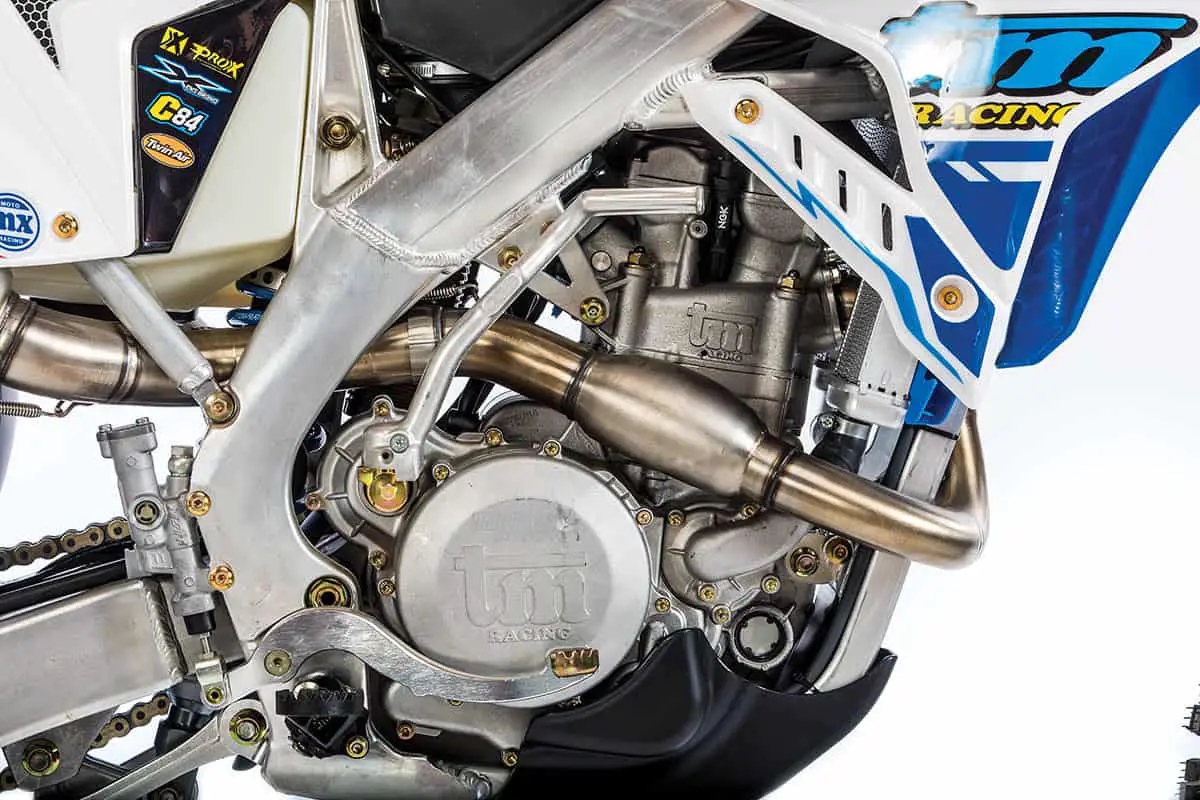
Q: WHAT DO WE THINK OF THE ENGINE?
A: From its outer appearance, the 2018 castings look like the 2004 castings. The engine cases, head and many other components have remained the same for all these years. What you don’t see from the outside is that the Italian engineers have been making internal changes to improve the overall performance. In 2016, we described this engine as a diesel locomotive when compared to the KX-F, CRF, KTM, YZ-F or RM-Z. It started out mellow, stayed mellow and just kept pulling. It had power everywhere in the rpm range, but it didn’t impress the MXA test riders. We like a 450 powerplant to be mellow yet powerful; the 2016 TM was just mellow. It was boring.
The 2018 engine feels completely different from the 2016 engine. Even though not much has changed, the 2018 TM MX450-FI engine has pep in its step. It has a powerful bottom-to-midrange thrust that gets you from corner to corner quickly. There is one caveat—over-revving the engine is not advisable. It does not fall flat, but once you shut off at high rpm, the engine braking is excessive and throws your body weight forward. MXA test riders avoided this feeling by short-shifting the throaty engine. Plus, our testers couldn’t stand the super-loud reverberation noise coming from the forward-mounted airbox when the bike was revved to the moon.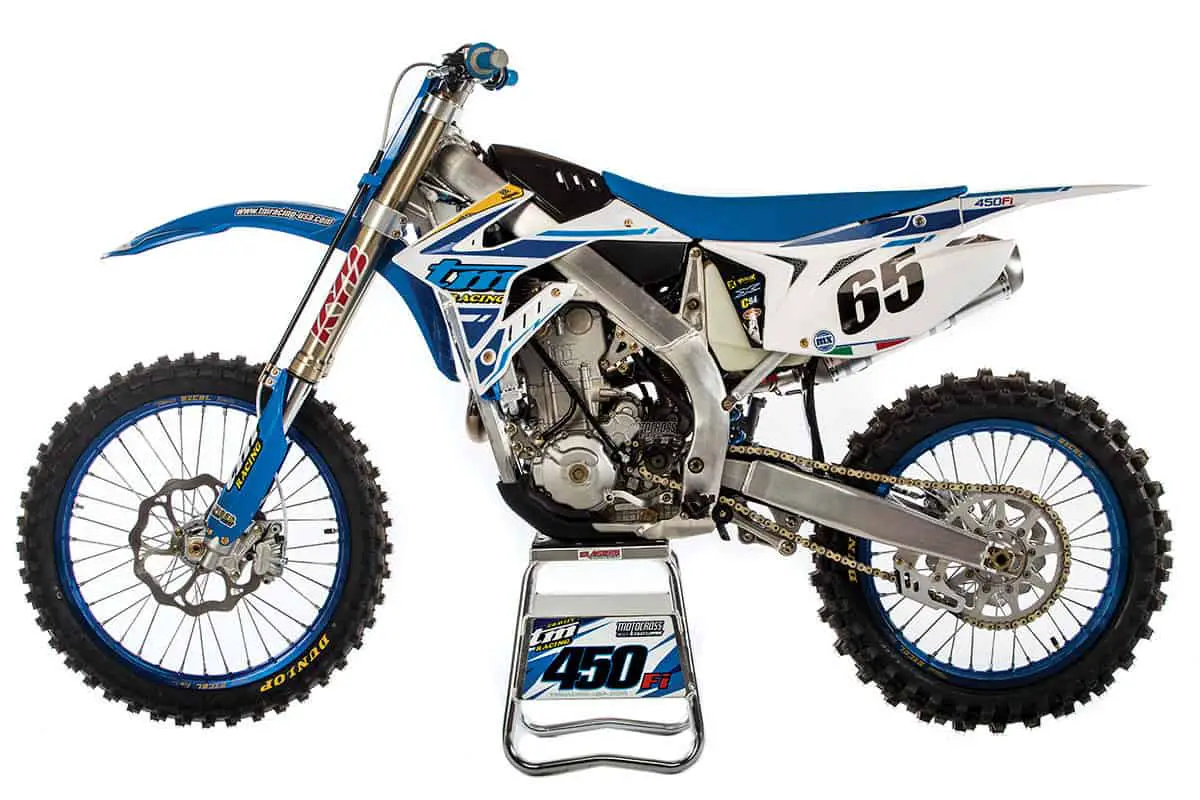 Riding this bike reminds us of the warm, fuzzy feeling we got when riding the 2005-through-2008 Honda CRF450s. Believe us when we tell you that is a compliment.
Riding this bike reminds us of the warm, fuzzy feeling we got when riding the 2005-through-2008 Honda CRF450s. Believe us when we tell you that is a compliment.
Q: HOW DID THE TM MX450-FI HANDLE?
A: Like a 2005 to 2008 Honda CRF450 with better cornering. It is no secret that this bike is hefty. You can tell just by looking at it. Chunky or not, the TM tracks straight as an arrow and has incredibly precise cornering. The old-style CRF450 handling is felt when mistakes are made. If you miss your line, get cross-rutted, or under- or over-jump, the heavier bike makes getting back on track cost time. We liked that it reminded us of our favorite CRF450, because we have fond memories of that bike.
Q: DO THE KAYABA SSS FORKS FEEL LIKE REAL SSS FORKS?
A: Every TM that we’ve tested prior to the 2018 MX450-FI gave Kayaba SSS forks a bad name. TM has been able to put a black mark on the fabulous SSS forks, because otherwise they are great. Even though TM had the same basic forks as Yamaha, they were atrocious. The TM’s version of the SSS was harsh at the top of the stroke and soft on the bottom. We felt they would work better if they were turned upside down.
Jump forward to 2018 and TM has updated its Kayaba SSS forks. They are a breath of fresh air. They actually feel like they’re related to the Kayaba SSS family and not the red-headed stepchild of the bunch. They were a bit on the stiff side at first, but we were able to iron that out with the compression clicker.
Q: HOW DID THE IN-HOUSE-MADE TM SHOCK WORK WITH THE KAYABA FORKS?
A: The previous 5.2 kg/mm shock spring was too stiff for any under-240-pounder. It made the rear end of the chassis feel super tall and transferred the load to the under-performing SSS clones. This produced a very unbalanced chassis. Once we rode with the softer 4.8 kg/mm shock spring, which comes standard on the 2018 MX450-FI, the bike floated in the sweet spot of the stroke. The TM still felt tall in the rear at 105mm of sag. We went down to 110mm and everything was hunky-dory. With this race sag, the chassis felt perfectly balanced front and rear. To make the bike even better, we feel that the subframe should be cut down 5mm, which would lower the rear of the seat by 15mm. Ralf Schmidt is working on getting an adjustable subframe made so riders can tailor the height to their liking.
On a strange note, when the mid-body fuel tank was full, the rear of the MX450-FI worked better than when the tank was low on fuel. Since the TM’s fuel tank is mounted above the shock and under the seat, it makes sense that riders can feel a difference in the weight bias.
Q: WHAT WOULD WE DO IF WE WERE ITALIAN BOUTIQUE BUILDERS?
A: We asked the same question in 2016. We complained that the shock was too stiff, the forks were harsh, the bike was too hard to start, it sat too tall, the gearing was Bonneville Salt Flats tall, the handlebars were high-risers and the gas cap was impossible to open. Thankfully, for 2018, many of our complaints were answered. We still think the gas cap needs a better design, but the takeaway from this is that TM is listening to the American market. KTM went through the same growing pains with the wants and needs of American racers.
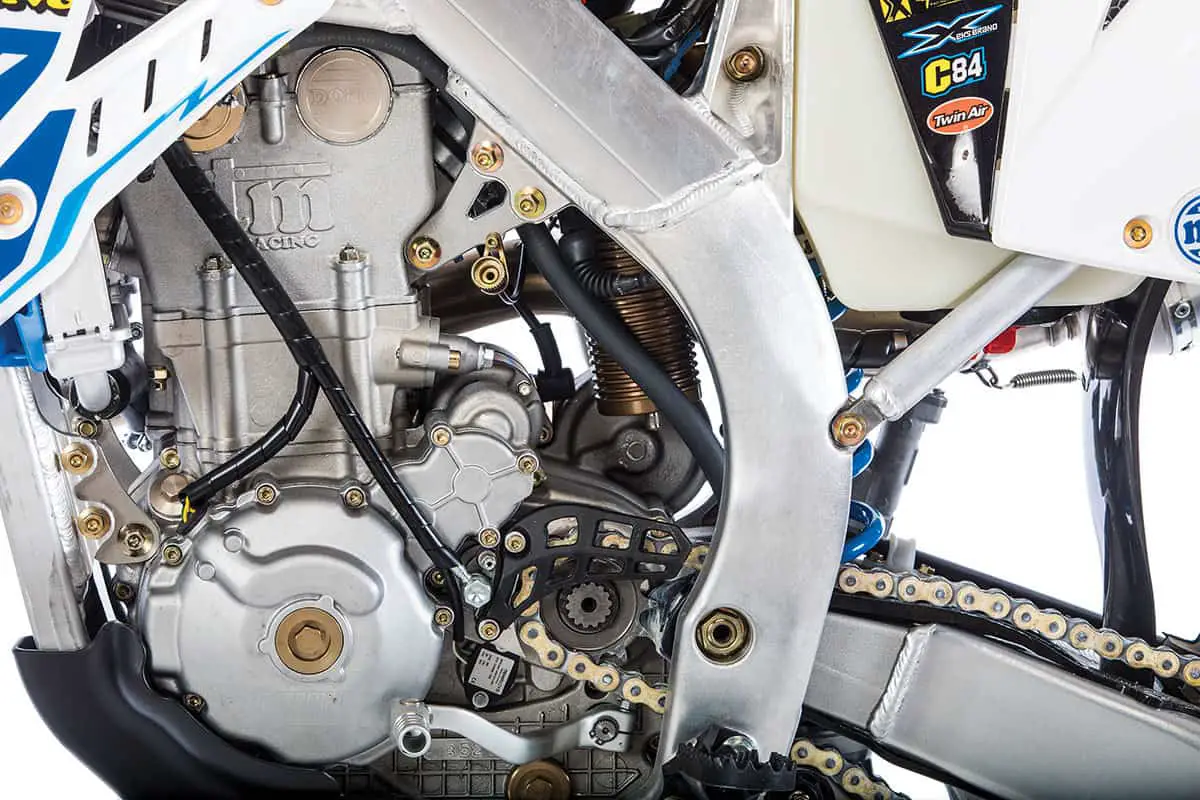
Since TM has updated its bike, we need to update our list.
(1) Starting. American TM importer Ralf Schmidt is importing all the MX450-FIs with the optional electric starter installed. Good move, but a better move would be for TM to downsize the package so that the electric starter could be installed without adding weight.
(2) Engine braking. TM has decreased the engine’s decompression braking over the last few years; however, it can still catch you off guard if you miss your shift point and rev the bike out. A few years ago, the decompression braking was so strong when you rolled the throttle off that the brakes weren’t necessary. For 2018 TM has made a major leap forward in decreasing the chug-chug-chug. We’d like it reduced even more.
(3) Weight. The TM MX450-FI is big and it is heavy. TM, along with Honda, Suzuki and Yamaha, needs to put its 450s on serious diets.
Q: NOW THAT TM SIGNED MAX NAGL, WILL HE MAKE IMPROVEMENTS TO THE BIKE?
A: Yes and no. TM will make anything that Max wants. Different frames, engines, head angles—you name it and the small but mighty TM race shop will comply with Max’s every wish. Unlike AMA Pro racing, the MXGP series doesn’t have a production rule. They can race anything they want. Nagl says that TM will make him a bike that can win GPs. Hopefully, what Max wants, the rest of us will get in 2020. Works bikes are useless if their technology doesn’t trickle down to the production line.
Q: WHAT DID WE HATE?
A: The hate list:
(1) Rear sprocket bolts. We like that we don’t have to worry about the rear sprocket coming off mid-moto. In fact, we like that three sprocket bolts could fall out and the sprocket still wouldn’t even wiggle. Why not? Because TM’s rear sprockets are held on by nine bolts. That’s overkill.
(2) Height. With the lighter shock spring, the bike feels much lower to the ground than in the past, but it is still too tall. If it were us, we would cut the subframe and shorten the shock.
(3) Tires. Mitas tires would not be our first choice, even though they are a Czech Republic company that owns both Barum and Trelleborg.
(4) Airbox. We like the straightforward and simple design of the TM’s front-mounted airbox, but the large airbox vents make the bike annoyingly loud at high rpm.
(5) Gas cap. We love the side-mounted gas cap. It is very Formula 1, but we couldn’t get the small gas cap off without using a pair of pliers.
(6) Shifting. Under a load, shifting gets notchy.
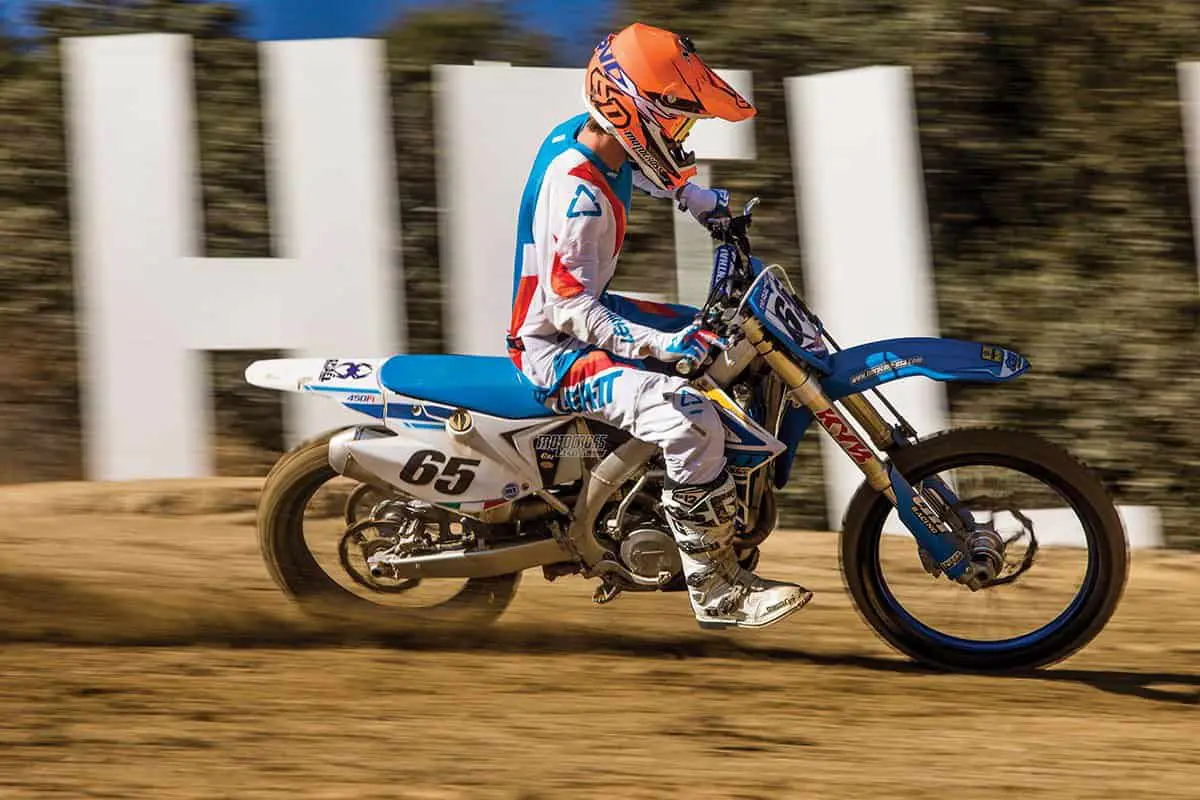
Q: WHAT DID WE LIKE?
A: The like list:
(1) Brakes. The TM’s 270mm Galfer front rotor and Brembo hydraulics make it the most powerful production brake made—even better than KTM brakes.
(2) Wheels. The blue Takasago Excel rims are laced to very sleek, polished spool hubs.
(3) Suspension. This year’s front forks don’t feel like fake Kayaba SSS forks anymore. They are the real thing.
(4) Hydraulic clutch. The self-adjusting hydraulic clutch is great.
(5) Handling. This is a great-handling bike. It can turn on a dime and has good straightline stability.
(6) Gearing. The last time we tested a TM MX450-FI, we complained bitterly about the 14/50 gearing being way too tall. The changes that TM made for 2018 suit a 450 much better.
(7) Contact patch. All our testers liked that the TM offered a lot of grip for their legs. The contact patch is much bigger than on most brands.
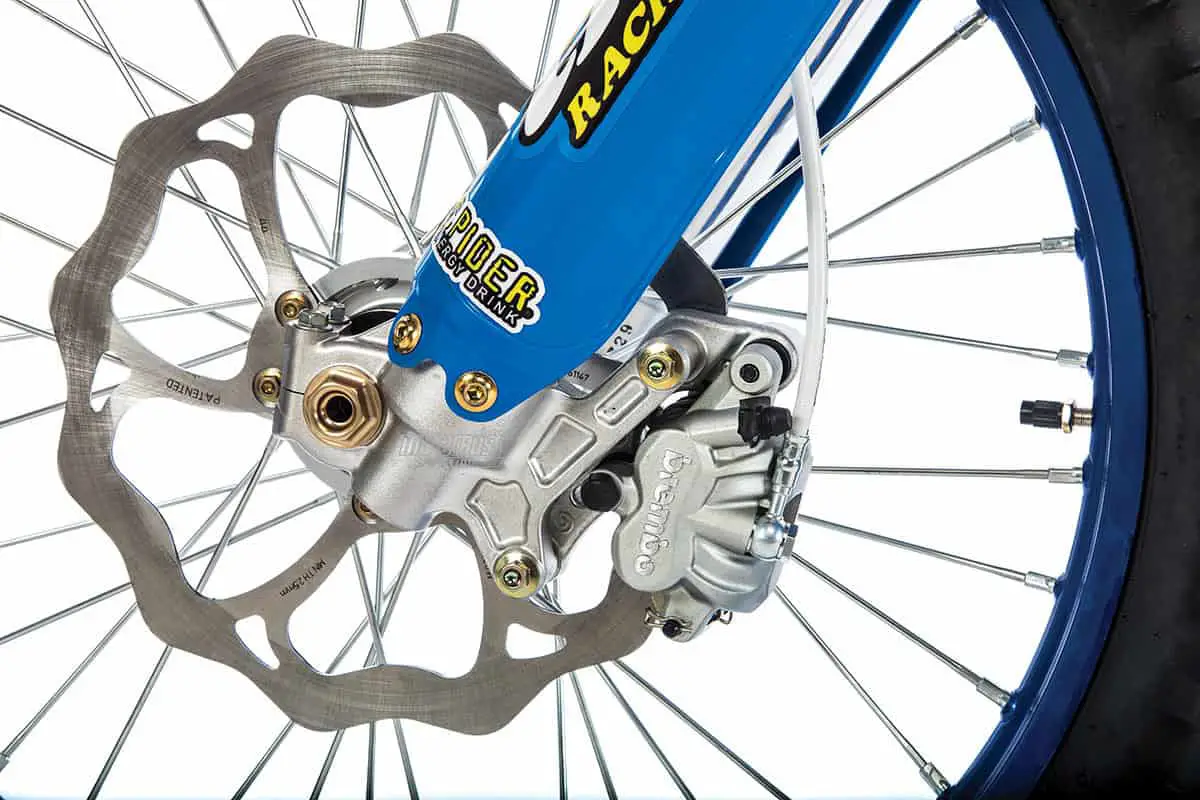
Q: WHAT DO WE REALLY THINK?
A: People always ask us why we don’t include the TM MX450-FI in our annual shootout. There are a few reasons, but the biggest one is that TM is best known in America as a two-stroke company, thus they import fewer MX450-FIs a year than new Rembrandt paintings are found at garage sales. These bikes are rare, but their scarcity hasn’t hampered their competitiveness. The 2018 TM MX450FI can run with the big dogs.
MXA’S 2018 TM MX450-FI SETUP SPECS

This is how we set up our 2018 TM MX450-FI for racing. We offer it as a guide to help you find your own sweet spot.
KAYABA SSS FORK SETTINGS
For hardcore racing, we ran this setup on the 2018 TM MX450-FI (stock settings are in parentheses):
Spring rate: 0.45 kg/mm
Compression: 13 clicks out (16 clicks out)
Rebound: 13 clicks out
Fork height: 5mm up
Notes: In most cases, Kayaba SSS forks are the best forks made, but they are not good with the wrong valving. TM made some major strides in getting workable settings in the 2018 TM MX450-FI. They are a little stiff for the average rider, but once we went out on compression, we got them dialed in.
TM SHOCK SETTINGS
For hardcore racing, we ran this setup on the 2018 MX450-FI (stock settings are in parentheses):
Spring rate: 4.8 kg/mm
Race sag: 110mm (105mm)
Hi-compression: 2 turn out
Lo-compression: 15 clicks out
Rebound: 20 clicks out
Notes: TMs have always had a stinkbug feel to them. In the past we lowered the sag to 115mm, running a softer shock spring and sent the shock out to have it shortened. For 2018, TM made changes in the right direction to lower the rear of the bike, along with going from a 5.2 kg/mm spring to a lighter 4.8 kg/mm. This allowed the MX450-FI to have a balanced feel without much tweaking.


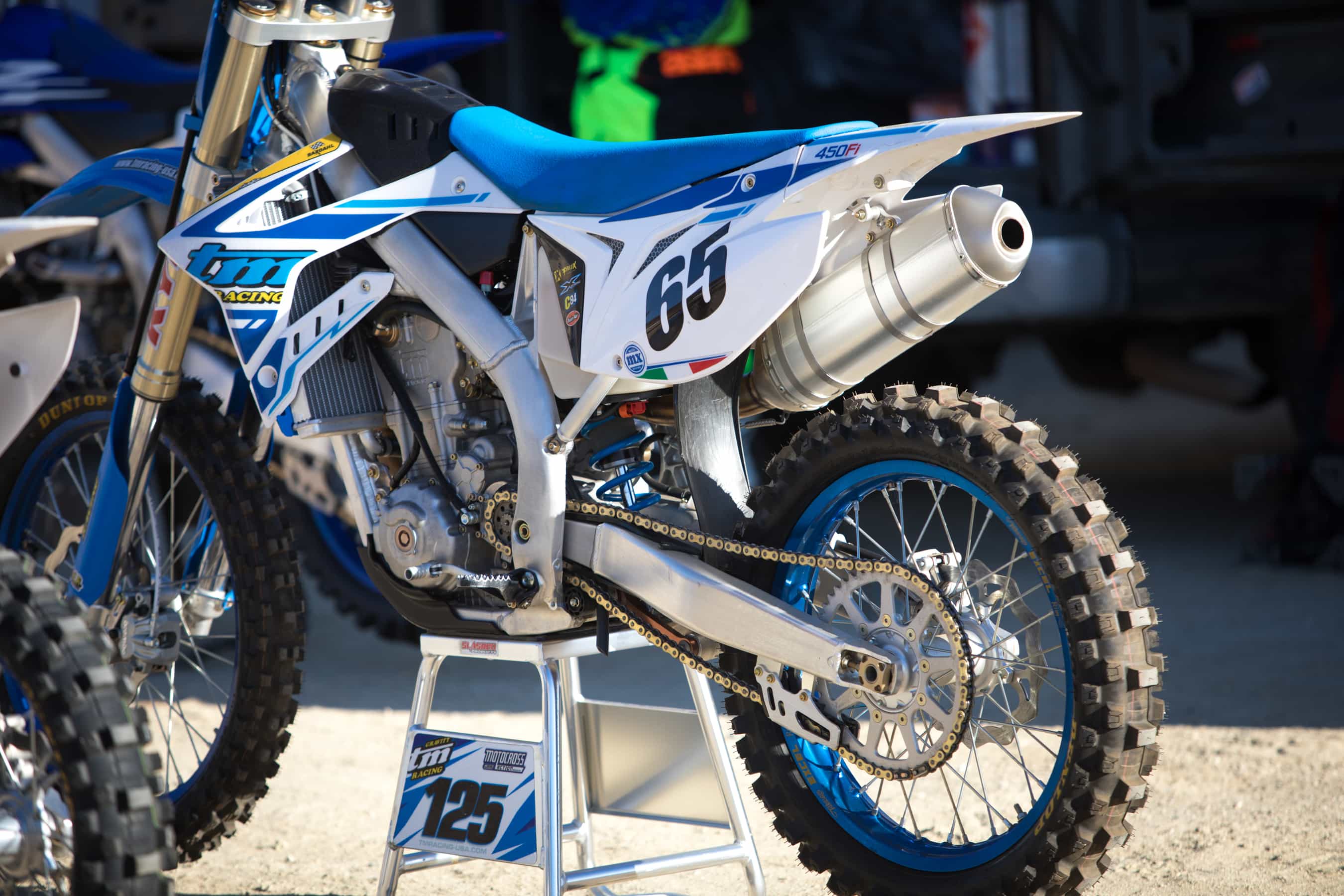
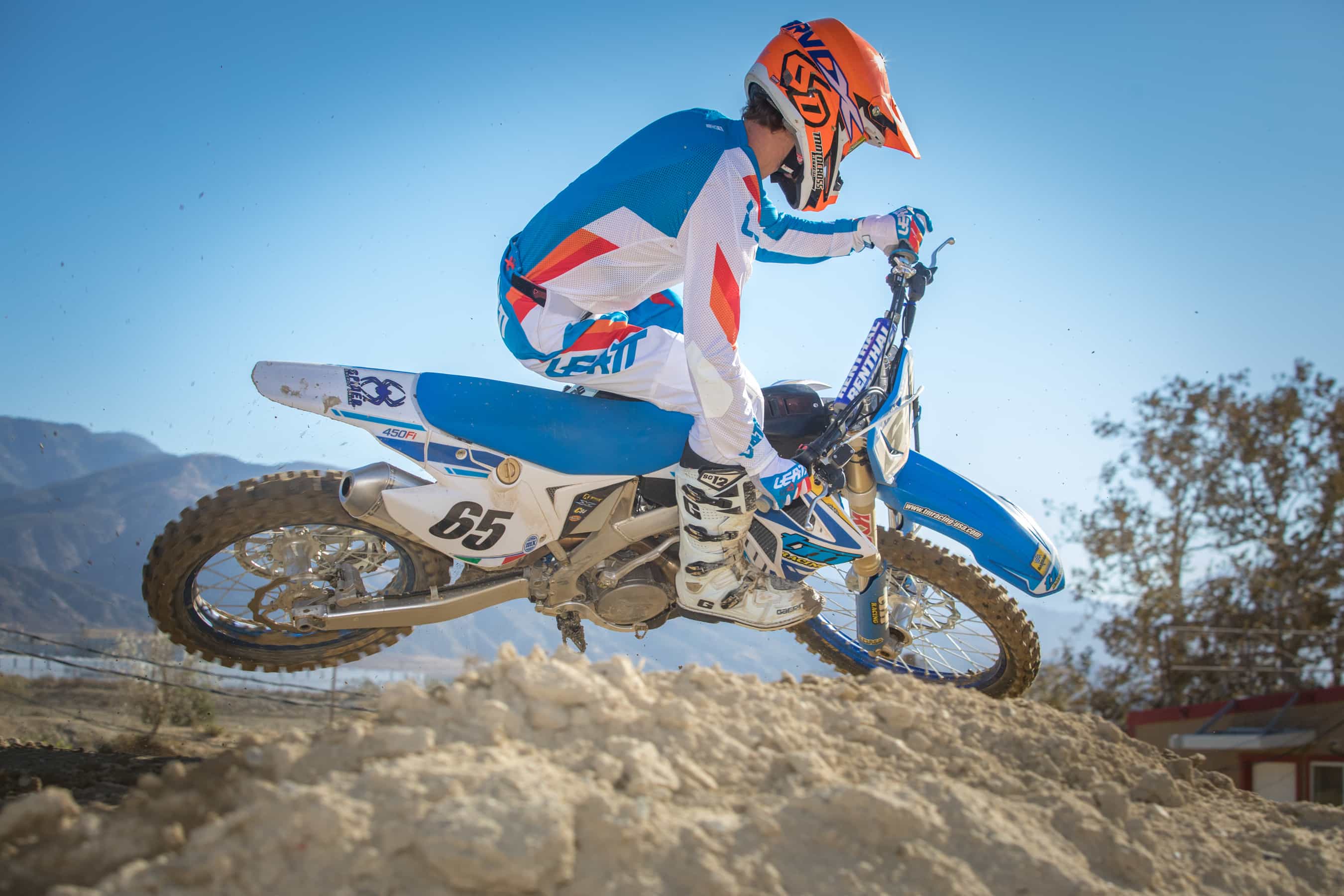
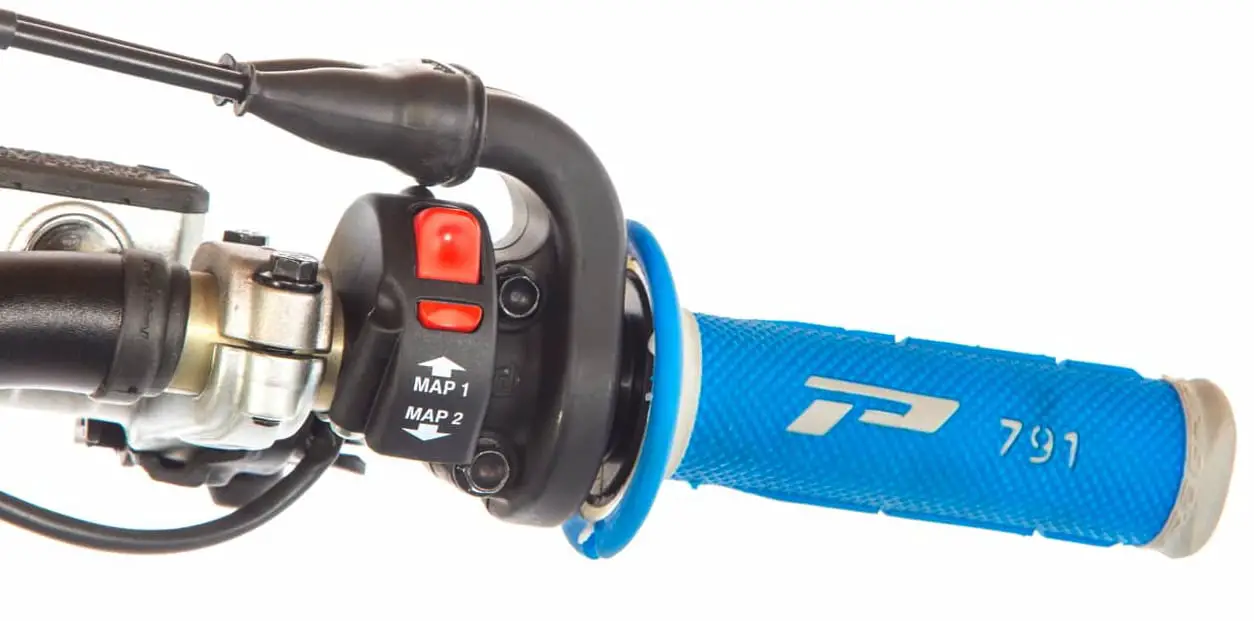
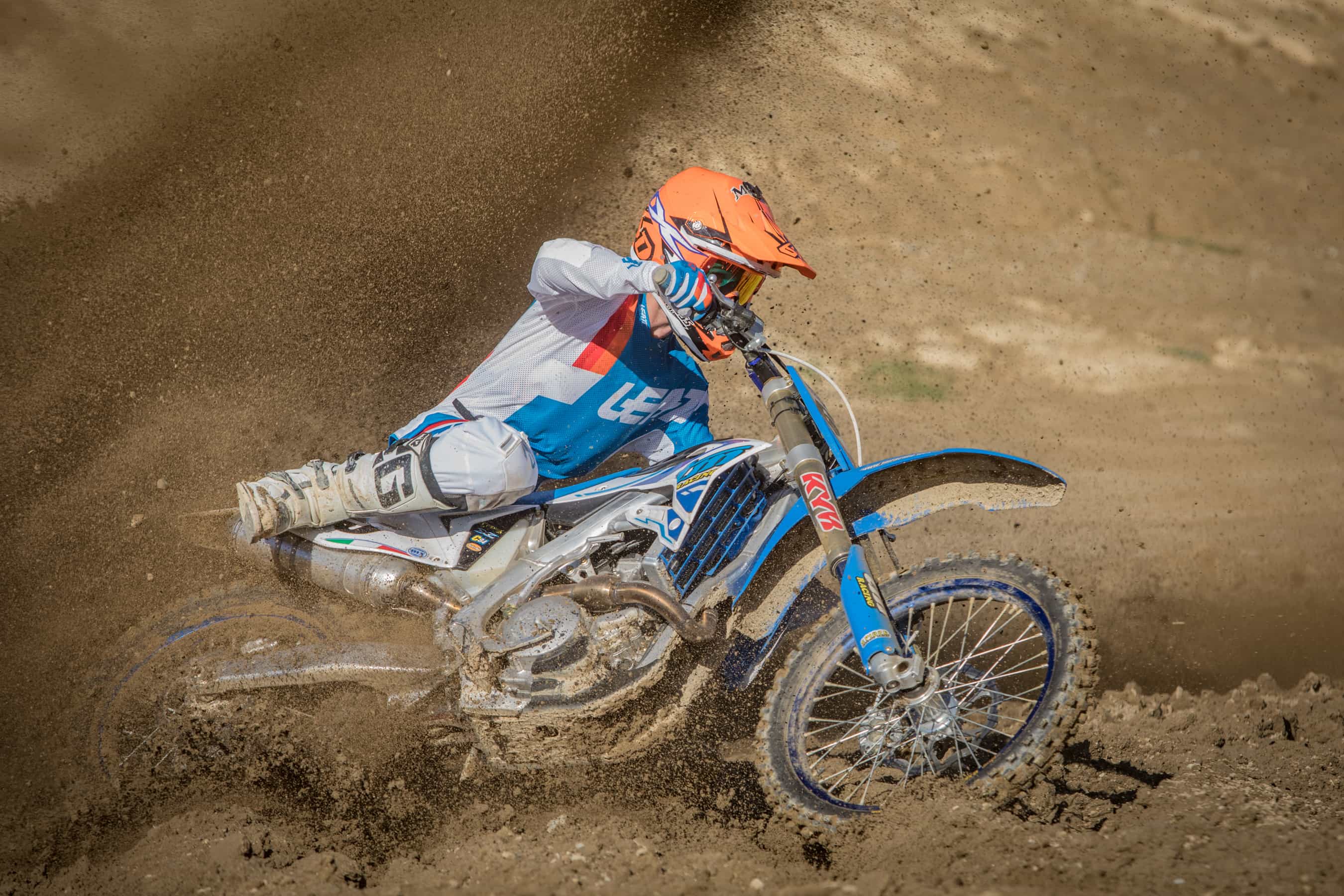


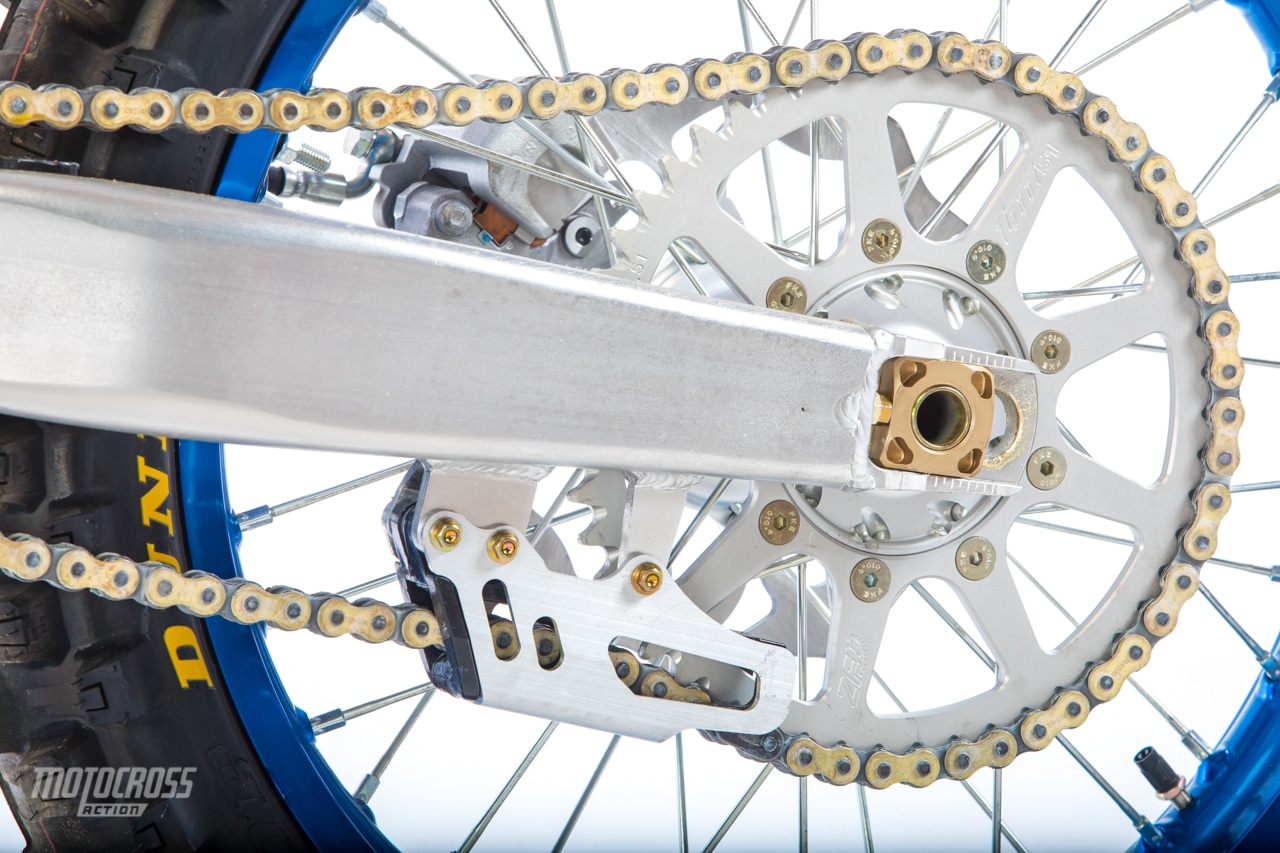



Comments are closed.